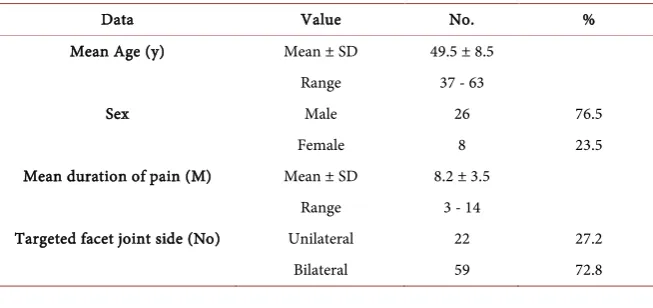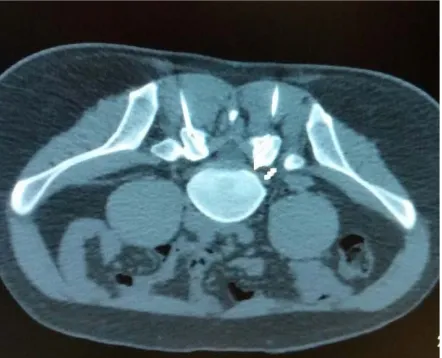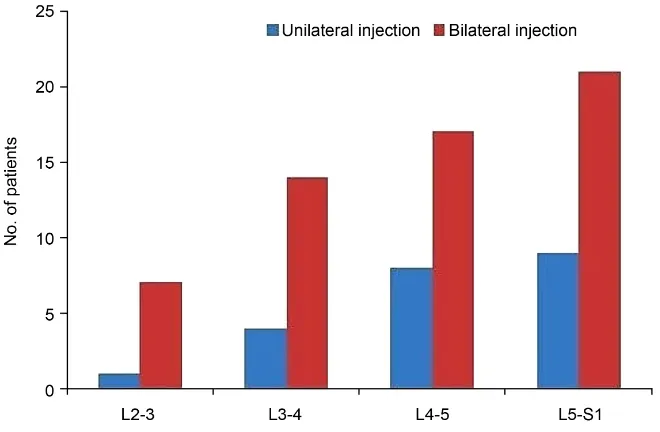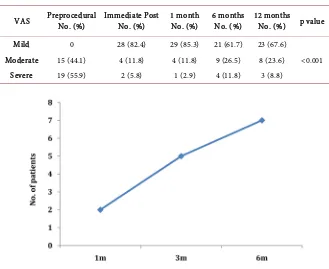http://www.scirp.org/journal/ojmn ISSN Online: 2163-0585
ISSN Print: 2163-0569
DOI: 10.4236/ojmn.2019.92012 Apr. 1, 2019 123 Open Journal of Modern Neurosurgery
CT-Guided Lumbar Facet Joint Infiltration:
Accessibility, Accuracy and Functional Outcome
Ahmed Elsayed
1*, Walaa Y. Elsabeeny
21Department of Neurosurgery, Cairo University, Cairo, Egypt
2Department of Anesthesia and Pain Management, National Cancer Institute, Cairo University, Cairo, Egypt
Abstract
Background: Pain generated from lumbar facet joint affection is considered a common cause of low back pain. Image-guided facet joint infiltration is per-formed to reduce pain severity and to confirm its source. Aim: The objective of this study is to assess the accessibility, and accuracy and to evaluate the functional outcome of the CT-guided lumbar facet joint infiltration in man-agement of low back pain. Subjects and Methods: This retrospective study included thirty four patients. All patients were diagnosed with low back pain due to lumbar facet syndrome. Adequate conservative therapy failed to im-prove the patient’s symptoms. Totally, 81 lumbar facet joints were treated by CT-guided intra-articular infiltration. Mean time of hospital stay was 6 - 8 hours. In the procedure technique, measures were applied to reduce the pa-tients’ radiation exposure. The response to treatment was evaluated by the visual analogue scale (VAS) before procedure and at follow-up visits. Results: Among 34 adult patients included in this study, 26 were males and 8 were females. The mean age was 49.5 ± 8.5 years. Mean Duration of low back pain on admission was 8.2 ± 3.5 months. Bilateral CT-guided intra-articular infil-tration was performed in 23 patients (67.5%). Assessing the response after fa-cet joint infiltration, 82.4% of the patients showed immediate pain improve-ment after the procedure; 85.3% of the patients reported pain relief after 1 month and 67.6% at 12 month follow up. There was a statistically significant relief of pain after the intervention at 12 month follow up (p < 0.001). Con-clusion: Lumbar Facet joint infiltration guided with CT scanning seems to be a reliable and safe procedure for low back pain management. Beside imme-diate and long term pain relief achieved using this minimally invasive tech-nique; CT guidance provides an accessible and accurate route for the needle with low radiation dose exposure.
Keywords
Low Back Pain, Accuracy, CT, Lumbar Facet Joint
How to cite this paper: Elsayed, A. and Elsabeeny, W.Y. (2019) CT-Guided Lum-bar Facet Joint Infiltration: Accessibility, Accuracy and Functional Outcome. Open Journal of Modern Neurosurgery, 9, 123-131. https://doi.org/10.4236/ojmn.2019.92012
Received: February 16, 2019 Accepted: March 29, 2019 Published: April 1, 2019
Copyright © 2019 by author(s) and Scientific Research Publishing Inc. This work is licensed under the Creative Commons Attribution International License (CC BY 4.0).
DOI: 10.4236/ojmn.2019.92012 124 Open Journal of Modern Neurosurgery
1. Introduction
Pain emerging from facet joint is considered as a common cause of axial low back pain in adults with a prevalence rate ranging from 15% to 52% [1][2]. Pain may be generated from any part of the facet joint as the fibrous capsule, bone and the synovial membrane [3].
Facet joint-mediated pain is not easy to diagnose; physical examination and radiological findings are unreliable to confirm the diagnosis of facet joint syn-drome. Many surgeons diagnose facet joint pain mainly by clinical examination and by excluding other causes of axial low back pain [4][5]. Image-guided facet joint interventions have emerged rapidly as noninvasive nonsurgical techniques with a reliable diagnostic and therapeutic means [6].
These interventions include ultrasound-guided, fluoroscopy or computed to-mography scanning. Optimum precise localization of the needle tip can be achieved through the image guidance; also undesirable complications can be avoided [7]. Intra-articular facet joint infiltrations are beneficial for the diagno-sis and management of facet joint pain. On the other hand, other nonsurgical procedures as neurolysis and radiofrequency denervation of medial branch nerves are mainly used to treat rather than to diagnose facet joint pain [8].
Considering the microanatomy of the lumbar facet joint and osteoarthritis presence which leads to difficulty in obtaining accurate precise needle access by fluoroscopy only, computed tomography (CT) scanning provides a minimally invasive, proper needle guidance and reliable precise needle placement in the axial plane with high anatomic resolution [9].
The aim of the present study is to review the accessibility and technical accu-racy of the procedure and to evaluate the clinical outcome after intervention.
2. Subjects and Methods
Thirty four patients were included in this retrospective series, 26 males and 8 females, their mean age was 49.5 ± 8.5 years. All the procedures were performed at Cairo University hospital and Ahalia hospital in the period from 2014 to 2016. Ethical approval was obtained by Neurosurgery ethical review committee in our institution, and informed consent was not required to this retrospective study. All patients were evaluated clinically and radiologically before the intervention.
Patients included in this study suffered axial low back pain due to lumbar fa-cet syndrome for a duration ranging from 3 to 14 months (mean duration: 8.2 ± 3.5 months), not responding to conservative treatment and they all had CT-guided intra-articular facet joint infiltration. Before the intervention, the involved facet joint showed signs of degeneration and inflammation in magnetic resonance imaging (MRI). Exclusion criteria included other causes of low back pain as her-niated disc, spinal deformity, spondylolithesis, and radicular symptoms, history of any neurological deficits, possible pregnancy, coagulation defect and previous spinal surgeries.
DOI: 10.4236/ojmn.2019.92012 125 Open Journal of Modern Neurosurgery
and 23 (67.5%) had the intervention bilaterally. The total number of facet joints injected was 81.
Back pain was assessed using Visual Analogue Scale (VAS) before procedure and immediate post procedure. We instructed the patients to attend in our out-patient clinic 3 - 4 weeks after the intervention for control evaluation and after 6, 12 months for follow-up. Patient’s demographic data was shown in Table 1.
3. Procedures
Patients were placed in prone position and the angle of CT scanner was adjusted to be 0 angle. In order to reduce radiation exposure to the patients, an initial low dose scan was applied to the targeted facet joint with average length of 6 cm only per level obtaining 5-mm axial sections. Using the light marker in the CT scan-ner, needle entry point on the skin was localized. After skin has prepped and draped, local anesthesia was administrated and a 22-G needle was advanced into the joint in slight oblique (5 - 10 degrees) or straight direction. Needle angula-tions are determined according to the facet joint inclination until it reaches the lip of the facet joint. Fine maneuver was followed to enter the facet joint capsule to minimize number of scans taken. We used intraarticular contrast only in five cases to confirm needle position as in most of cases the CT scanning verified the joint line clearly. In the bilateral infiltration cases, both sides’ needles were serted before scanning. Low-dose (120 kV, 60 mAs) scans were performed in-termittently in step-and-shoot mode over the limited planned targeted area to verify the needle position. 0.5 ml of 0.25% bupivacaine and 0.5 ml (20 mg) of methylprednisolone acetate were injected into the intra-articular facet joint. Post procedural, the patient was observed for 1 hour to observe the pain relief and to detect any possible complication like allergic reactions (Figure 1 and Figure 2).
4. Statistical Analysis
[image:3.595.208.535.582.736.2]Statistical analysis was done using IBM SPSS statistics version 24. Numerical da-ta were presented as mean ± sda-tandard deviation and range. Categorical dada-ta were presented as frequencies and percentages. Comparison of VAS score overtime was done by Cochrane test. A probability value (p value) less than 0.05 was
Table 1. Patient’s demographic data.
Data Value No. %
Mean Age (y) Mean ± SD 49.5 ± 8.5
Range 37 - 63
Sex Male 26 76.5
Female 8 23.5
Mean duration of pain (M) Mean ± SD 8.2 ± 3.5
Range 3 - 14
Targeted facet joint side (No) Unilateral 22 27.2
DOI: 10.4236/ojmn.2019.92012 126 Open Journal of Modern Neurosurgery
Figure 1. CT-guided facet injection with the needle in the targeted position (arrow).
Figure 2. Axial prone CT scan shows bilateral facet joint injection.
considered statistically significant.
5. Results
All patients enrolled in the study had CT-guided lumbar facet joint infiltration with a total of 81 infiltrated facet joints. Targeted levels for facet joint infiltration including the redo cases were showed in Figure 3.
Using VAS (range from 0 - 10), we sorted the enrolled patients clinically into the following categories: 0: No pain, 1 - 3: Uncomfortable or mild pain, 4 - 7: Dreadful or moderate pain and 8 - 10: Horrible or severe pain.
The collected data were retrospectively reviewed and showed that 82.4% of the patients showed immediate pain improvement within one hour after the proce-dure reporting no or mild back pain, the percentage increased at 1 month evalu-ation to be 85.3% and was 67.6% at 12 month follow up. Post procedural all pa-tients were neurologically intact.
[image:4.595.264.485.271.450.2]DOI: 10.4236/ojmn.2019.92012 127 Open Journal of Modern Neurosurgery
Figure 3. Targeted facet joint levels for injection.
pain relief for almost 6 months and 6 patients (17.6%) reported no pain relief immediately after the procedure. Analysis of patient’s clinical outcome is shown
in Table 2.
Due to recurrence of symptoms or non-improvement, Reinjection was per-formed to 2 patients (5.8%) at 1 month after the procedure, 5 patients (14.7%) at 3 month but one of them required reinjection again with another six patients at 6 month (Figure 4).
6. Discussion
Multiple nonsurgical interventions are currently used for the management of fa-cet joint syndrome. Of these interventions, CT intra-articular fafa-cet joint infiltra-tion is considered as an emerging noninvasive modality for diagnosis and man-agement of pain generated by the facet joint where it takes the advantage of bet-ter needle visualization with lesser side effects [10][11].
Radiologically, it is difficult to confirm the diagnosis of facet joint syndrome. Facet arthritis, degeneration or effusion can be seen in different imaging even if the patient has no pain symptoms. We focused on clinical signs eliciting the fa-cet generated pain. Patients enrolled in our study showed localized tenderness on the affected facet joint with deep pressure, back pain exacerbation with hyperextension or lateral bending and diffuse referred pain over the buttock. However, the primarily diagnostic facet joint blocks through CT scanning con-tributed to confirm the exact pain source and involved facet [12].
DOI: 10.4236/ojmn.2019.92012 128 Open Journal of Modern Neurosurgery
Table 2. Clinical results of patients (measured by VAS score).
VAS Preprocedural No. (%) Immediate Post No. (%) 1 month No. (%) 6 months No. (%) 12 months No. (%) p value
Mild 0 28 (82.4) 29 (85.3) 21 (61.7) 23 (67.6)
<0.001
Moderate 15 (44.1) 4 (11.8) 4 (11.8) 9 (26.5) 8 (23.6)
Severe 19 (55.9) 2 (5.8) 1 (2.9) 4 (11.8) 3 (8.8)
Figure 4. Patients needed facet joint re infiltration.
operating personnel, it cannot be used in obese patients as there is difficulty to properly visualize deep structures [13][14].
CT scan guidance offers highly anatomic and spatial resolution in the axial plane leading to accessible needle localization [15][16].
DOI: 10.4236/ojmn.2019.92012 129 Open Journal of Modern Neurosurgery
infiltration and application of fine maneuvers after touching the facet joint to enter the capsule. Markus et al. followed a near technique in his study performed on 37 patients. He reported that after 84 lumbar facet joints were injected, the totalamount of used radiation in the procedures was low. He measured the av-erage radiation intensity in the procedure and found that it is less than the ac-credited reference dose valued by the American College of Radiology for the normalized adults abdominal CT scans by 25% [18].
We didn’t report any major complications in our study as we tried to be me-ticulous in the technique and sterilization. Other researches mentioned that intraarticular facet injection may result in dural puncture, neural trauma, bleed-ing or infection. These complications rates reach 5% - 10% with fluoroscopy compared to 0.5% rate only with the CT guided injection [19][20].
In our research, we monitored the response after injection of 81 facet joints. The results showed immediate pain relief after the procedure in 82.3% of pa-tients but the peak was after 1 month as 85.2% of papa-tients showed pain im-provement. We believe that proper patient selection and accuracy of the CT scanning contributed to achieve these results. Most of the patients needed rein-jection due to non improvement or recurrence of pain after 6 months, 20.5% of the enrolled patients received intraarticular injection. At long term follow up, the percentage of pain relief declined to be 67.6% at 12 month. Near results were obtained by Artiet al after injection of 141 facet joints, significant pain relief was obtained in 81.8% patients 1 hour after the procedure, in 93.3% after 4 weeks and in 85.7% after 12 weeks [17].
We didn’t find difficulties in proper patients’ selection or locating the facet joint space using the CT scan guidance leading to accurate needle placement. Some limitations were associated with our study as it included small numbers of cases and the high cost of CT device utilization which favors the fluoroscopy fa-cet injection with less expense. Accuracy of CT guided fafa-cet joint block was also studied by Weininger et al. retrospectively on 37 patients with a total number of 84 facet joint blocks. The study showed that using CT is a safe, rapid and reliable imaging tool with high accuracy for lumbar facet joint block [21].
7. Conclusion
This study showed that CT-guided intra-articular facet joint infiltration provides short and long term pain relief in cases with low back pain. Accessible and accu-rate needle placement could be achieved through this safe and reliable minimally invasive technique.
Conflicts of Interest
The authors declare no conflicts of interest regarding the publication of this pa-per.
References
DOI: 10.4236/ojmn.2019.92012 130 Open Journal of Modern Neurosurgery Displayed during CT: What Good Are They? Radiology, 258, 236-242.
https://doi.org/10.1148/radiol.10100297
[2] Datta, S., Lee, M., Falco, F., Bryce, D. and Hayek, S. (2009) Systematic Assessment of Diagnostic Accuracy and Therapeutic Utility of Lumbar Facet Joint Interven-tions. Pain Physician, 12, 437-460.
[3] vanKleef, M., Vanelderen, P., Cohen, S., Lataster, A., Van Zundert, J. and Mekhail, N. (2010) Pain Originating from the Lumbar Facet Joints. Pain Practice, 10, 459-469. https://doi.org/10.1111/j.1533-2500.2010.00393.x
[4] Galiano, K., Obwegeser, A., Bodner, G., Freund, M., Maurer, H., Kamelger, F., Schatzer, R. and Ploner, F. (2005) Ultrasound Guidance for Facet Joint Injections in the Lumbar Spine: A Computed Tomography-Controlled Feasibility Study. Anes-thesia & Analgesia, 101, 579-583.
https://doi.org/10.1213/01.ANE.0000158609.64417.93
[5] Sehgal, N., Dunbar, E., Shah, R. and Colson, J. (2007) Systematic Review of Diag-nostic Utility of Facet (Zygapophysial) Joint Injections in Chronic Spinal Pain: An Update. Pain Physician, 10, 213-228.
[6] Friedly, J., Comstock, B. and Turner, J. (2014) A Randomized Trial of Epidural Glucocorticoid Injections for Spinal Stenosis. The New England Journal of Medi-cine, 371, 11-21. https://doi.org/10.1056/NEJMoa1313265
[7] Galiano, K., Obwegeser, A., Bodner, G., Freund, M., Maurer, H., Kamelger, F., Schatzer, R. and Ploner, F. (2005) Real-Time Sonographic Imaging for Periradicular Injections in the Lumbar Spine: A Sonographic Anatomic Study of a New Tech-nique. Journal of Ultrasound in Medicine, 24, 33-38.
https://doi.org/10.7863/jum.2005.24.1.33
[8] Schwarzer, A., Wang, S., O’Driscoll, D., Harrington, T., Bogduk, N. and Laurent, R. (1995) The Ability of Computed Tomography to Identify a Painful Zygapophysial Joint in Patients with Chronic Low Back Pain. Spine (Phila Pa 1976), 20, 907-912. https://doi.org/10.1097/00007632-199504150-00005
[9] Schauer, D. and Linton, O. (2009) NCRP Report No. 160, Ionizing Radiation Expo-sure of the Population of the United States, Medical ExpoExpo-sure—Are We Doing Less with More, and Is There a Role for Health Physicists? Health Physics, 97, 1-5. https://doi.org/10.1097/01.HP.0000356672.44380.b7
[10] Sujin, K., Joon, W., Jee, W., Guen, Y., Ja, Y., Heung, S. and Joong, M. (2015) Fluo-roscopy-Guided Intra-Articular Facet Joint Steroid Injection for the Management of Low Back Pain: Therapeutic Effectiveness and Arthrographic Pattern. Journal of the Korean Society of Radiology, 73,172-180. https://doi.org/10.3348/jksr.2015.73.3.172 [11] Aguirre, D., Bermudez, S. and Diaz, O. (2005) Spinal CT-Guided Interventional
Procedures for Management of Chronic Back Pain. Journal of Vascular and Inter-ventional Radiology, 16, 689-697.
https://doi.org/10.1097/01.RVI.0000156193.94573.48
[12] Mannion, A., Balagué, F., Pellisé, F. and Cedraschi, C. (2007) Pain Measurement in Patients with Low Back Pain. Nature Clinical Practice Rheumatology, 3, 610-618. https://doi.org/10.1038/ncprheum0646
[13] Wang, D. (2018) Image Guidance Technologies for Interventional Pain Procedures: Ultrasound, Fluoroscopy, and CT. Current Pain and Headache Reports, 22, 6. https://doi.org/10.1007/s11916-018-0660-1
Me-DOI: 10.4236/ojmn.2019.92012 131 Open Journal of Modern Neurosurgery ta-Analysis of Controlled Trials. Archives of Physical Medicine and Rehabilitation, 97, 1558-1563. https://doi.org/10.1016/j.apmr.2015.11.013
[15] Lee, J. and Lee, S. (2011) Comparison of Clinical Effectiveness of Cervical Transfo-raminal Steroid Injection According to Different Radiological Guidances (Carm Fluoroscopy vs. Computed Tomography Fluoroscopy). Spine Journal, 11, 416-423. https://doi.org/10.1016/j.spinee.2011.04.004
[16] Siegenthaler, A., Mlekusch, S., Trelle, S., Schliessbach, J., Curatolo, M. and Eichen-berger, U. (2012) Accuracy of Ultrasound-Guided Nerve Blocks of the Cervical Zy-gapophysial Joints. Anesthesiology, 117, 347-352.
https://doi.org/10.1097/ALN.0b013e3182605e11
[17] Arti, C., Sunil, C. and Rajiv, S. (2009) Image-Guided Lumbar Facet Joint Infiltration in Nonradicular Low Back Pain. The Indian Journal of Radiology and Imaging, 19, 29-34. https://doi.org/10.4103/0971-3026.44522
[18] Markus, W., Jared, C., Zoran, R., Giuseppe, B., Walter, H. and Alessandro, C. (2013) Accuracy of CT Guidance of Lumbar Facet Joint Block. AJR, 200, 673-676. https://doi.org/10.2214/AJR.12.8829
[19] Windsor, R., Pinzon, E. and Gore, H. (2000) Complications of Common Selective Spinal Injections: Prevention and Management. American Journal of Orthopedics, 29, 759-770.
[20] Saal, J. (2002) General Principles of Diagnostic Testing as Related to Painful Lum-barspine Disorders. Spine, 27, 2538-2545.
https://doi.org/10.1097/00007632-200211150-00027



